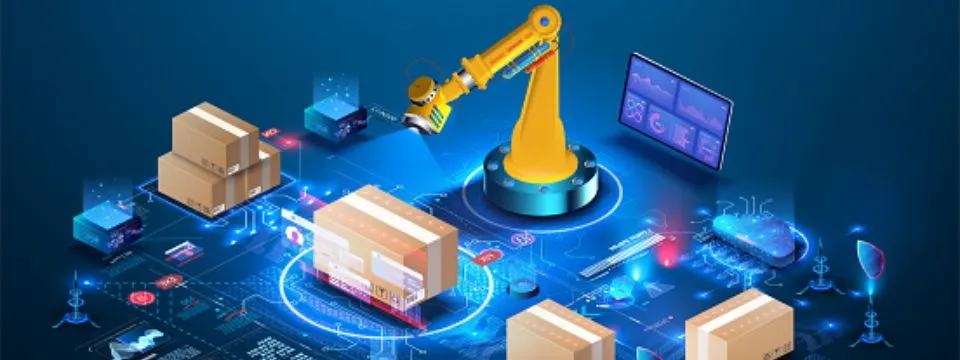Using IoT for Smarter Energy Management in Manufacturing
Author: Laila Meraj
03 December, 2024
The manufacturing industry is a significant energy consumer, accounting for nearly 54% of global energy use, according to the International Energy Agency. With rising energy costs and growing environmental concerns, optimizing energy consumption has become a business imperative for manufacturers worldwide.
This blog delves into how IoT (Internet of Things) is reshaping energy management in manufacturing, its key benefits, and the technologies driving this transformation. We will explore how manufacturers can adopt IoT to achieve sustainability goals, cut costs, and improve overall operational efficiency.

What is IoT-based Energy Management?
IoT-based energy management leverages smart sensors, cloud platforms, and real-time analytics to monitor and optimize energy use. By integrating IoT-capable devices into manufacturing systems, factories can collect energy data, automate processes, and identify inefficiencies. This provides manufacturers with actionable insights to reduce waste and enhance productivity.
Key components of an IoT-based energy management system include:
- Energy Measuring Devices: Sensors that capture data on energy consumption.
- IoT Cloud Platforms: Tools for storing, visualizing, and analyzing data.
- Smart Services: Automated solutions that drive decision-making and continuous improvement.
How IoT Transforms Energy Management in Manufacturing
1. Real-Time Monitoring and Data Collection
Traditional energy management relied on periodic data collection and manual analysis, which often led to delayed decision-making. IoT revolutionizes this by enabling real-time energy monitoring through connected devices.
For example, IoT-enabled energy measuring devices can capture granular energy data from various assembly lines. These devices send the data directly to cloud platforms, ensuring that energy managers have instant access to critical information. By visualizing this data, manufacturers can quickly detect abnormal energy consumption patterns and take corrective actions.
2. User-Friendly Visualization and Analytics
One of the most significant advantages of IoT systems is their ability to present complex energy data clearly and comprehensively. Advanced platforms like Xorbix Technologies provide services that enable users to visualize and evaluate energy data effortlessly.
3. Automation for Smarter Energy Use
IoT-based energy management introduces automation, reducing the manual effort required to monitor and control energy systems. Automation can:
- Dynamically adjust HVAC systems based on real-time occupancy data.
- Schedule high-energy processes during off-peak hours to minimize costs.
- Shut down idle machinery automatically to prevent unnecessary energy use.
This hands-off approach saves energy and allows employees to focus on core manufacturing tasks.
4. Predictive Maintenance
Energy-intensive equipment like compressors, motors, and conveyors can become inefficient over time due to wear and tear. IoT helps prevent this through predictive maintenance, which uses sensors to track equipment performance in real-time.
Predictive maintenance benefits include:
- Prolonged Equipment Lifespan: Timely repairs prevent energy losses caused by malfunctioning machinery.
- Reduced Downtime: Addressing issues proactively avoids disruptions to production schedules.
- Lower Maintenance Costs: Avoiding reactive maintenance saves both energy and expenses.
Benefits of IoT-based Energy Management
1. Improved Efficiency
IoT provides a holistic view of energy use, helping manufacturers eliminate inefficiencies. By identifying underperforming equipment or processes, factories can implement targeted improvements to optimize resource utilization.
2. Cost Savings
Automating energy management and reducing waste directly impact the bottom line. With IoT, manufacturers can achieve significant cost reductions through better energy procurement, lower peak-demand charges, and optimized usage.
3. Sustainability Goals
As global regulations around emissions tighten, IoT aids manufacturers in meeting sustainability goals. Smart systems enable factories to reduce their carbon footprint by promoting cleaner energy practices.
4. Scalability
IoT systems are highly adaptable, making them suitable for factories of all sizes. From small-scale workshops to large industrial plants, IoT can be scaled to match operational complexity.
Steps to Implement IoT-based Energy Management
- Assess Current Energy Systems: Conduct an audit to understand energy consumption patterns and identify inefficiencies.
- Choose the Right IoT Devices: Select energy-measuring devices that integrate seamlessly with your existing infrastructure.
- Leverage IoT Cloud Platforms: Use cloud-based solutions for data storage, visualization, and analysis.
- Train Your Team: Ensure energy managers and operators understand how to use IoT tools effectively.
- Continuously Monitor and Improve: Use insights from IoT systems to refine processes and achieve long-term energy goals.
The Future of IoT in Manufacturing Energy Management
The adoption of IoT in energy management is set to grow exponentially. Emerging technologies like AI-powered analytics and digital twins will further enhance IoT’s capabilities, allowing manufacturers to simulate energy-saving scenarios and predict outcomes with precision.
The global IoT market is projected to reach USD 650.5 billion by 2026, highlighting the increasing importance of IoT in various sectors, including manufacturing. Companies that invest in Internet of Things development services can leverage these advancements to enhance their operational efficiency and reduce their carbon footprint.
As renewable energy sources like solar and wind become more integrated into manufacturing, IoT will play a crucial role in optimizing their use. With Xorbix Technologies leading the way in IoT, factories can look forward to a future of sustainable, cost-effective operations.
Conclusion
IoT-based energy management is a game-changer for manufacturers aiming to improve efficiency, reduce costs, and meet sustainability goals. By leveraging real-time monitoring, automation, and predictive analytics, IoT empowers factories to achieve smarter energy use while staying competitive in a fast-evolving industrial landscape. With such advancement, you can anytime partner with Xorbix Technologies to implement custom IoT solutions tailored to your manufacturing needs.
Read more related to this blog:




